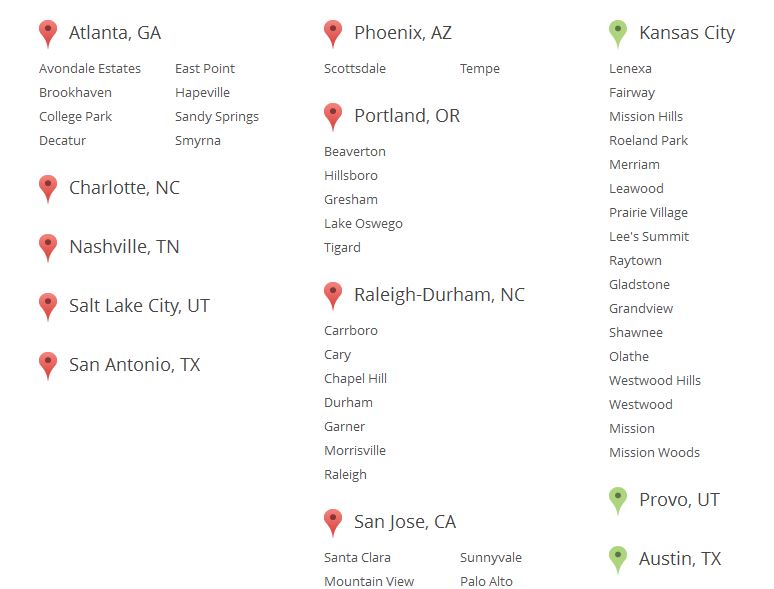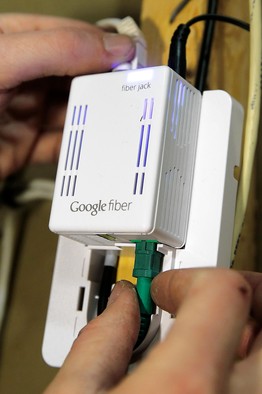
The ultrafast, one gigabit-a-second, fiber-optic Internet service known as Google Fiber, may be expanding into 34 additional cities across nine metropolitan regions, according to Google’s latest announcement. Discussions are underway with varying municipalities across the country to determine whether their infrastructure is fiber-optic-ready, in an effort to delegate some of the leg-work to cities themselves. Included in the talks are:

Green = current Google Fiber city; Red = potentially getting Google Fiber
Image courtesy of Google
The announcement differs from what was originally proposed back in 2011, when Google itself promised to take complete responsibility over installing the service. By contrast, the company invites the cities themselves to achieve the base infrastructural roadmap, ensure the utility poles are fiber-optic ready, and that all legal permits are in order; these criteria will be a determining factor as to whether a city receives the service. Google promised to notify all 34 cities by the end of 2014 whether they’ve made the cut.
News of the expansion plans arrived a short period of time following the announcement of Comcast and Time Warner Cable’s $45 billion merger, causing negative investor feedback; Comcast Corp’s stocks fell 3.7% and Time Warner’s fell 2.7%. Several of the proposed locations include cities where Comcast operates, such as Atlanta, San Jose, Portland and Nashville.

Google expects to charge $70 per month for the service; a small price to pay for speeds ranging up to one gigabit/second considering Comcast’s top broadband offering is half this speed and costs $399.94 a month. Using the service allows users to download web content 100 times faster than with the standard broadband most American households subscribe to.
Challenging the Comcast and Time Warner monopoly
The venture is a monopoly-buster for consumers in areas where cable/Internet service is provided exclusively by one company, as is the case in a large portion of the nation. One of the chief justifications made by cable and Internet lobbyists in favor of the Time Warner Cable and Comcast merger is that a merged entity is the same as two distinct entities because they each provide services to independent portions of the country. Therefore, the number of service options customers are entitled to remains the same. Alternatively, the fruition of fiber-optics in the form of Google Fiber challenges Comcast/Time Warner Cable to provide faster speeds and better prices.
Trading one freedom for another
One thing is for certain regarding the ongoing net neutrality debate: monopolies make it easier for service providers to strong-arm how you use the Internet and further diminish the value of net neutrality. So yes, having options is a victory for the consumer.
But before singing praises of having found a new champion in the battle against “evil corporations” and what not, consider the following: Google Fiber’s terms of service agreement bans users attaching legal devices of their choice to its network. In others, users are not allowed to run servers on their own broadband connection. Why is Google banning the use of servers? Experts speculate it’s the company plans to offer a business class service for running servers somewhere down the line.
Not being able to host personal servers means that Google Fiber customers are banned from remotely accessing media servers, SSHing into your home computer from an outside location, using a Raspberry Pi to host your blog, or even hosting a Minecraft or some other video game’s server. The limitation is preposterous to say the least, forcing customers to trade one freedom for another.
Given how deep the reliance on Internet services runs in our society, functioning as a backbone to both business and education, is it not safe to say that Internet service is more of utility than a convenience? That’s what the argument of net neutrality is all about and what federal regulators need to consider. And while Google Fiber may be more of an experiment than anything substantial, it nevertheless gives customers options and options are what threaten to steal customers.
Via WSJ and New York Times
Advertisement
Learn more about Electronic Products Magazine





